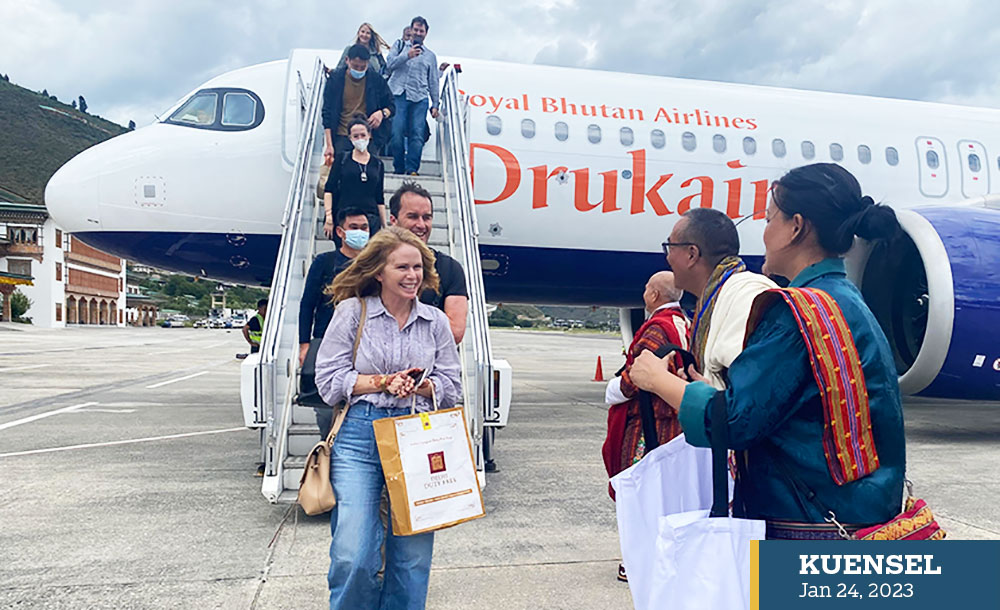Tourism is expected to pick up by the end of 2023
Jigmi Wangdi
The departure zone at the Paro International Airport is congested. However, most of the travellers are Bhutanese on their way for holiday or abroad for study and work.
The planes departing Paro are almost full.
Not far away from the departure zone, even with a flight landed, the arrival zone looks empty. The number of passengers on inbound flights, if indicative of flow of tourists, is not a good sign. Besides a few Bhutanese returning home from work, tour or holiday, the aircrafts are only half-filled, according to those returning home.
It is peak winter in Bhutan and the off-season for tourists, but those in the travel business say that before the pandemic and the new tourism policy, there were a good number of tourists visiting Bhutan in winter. Druk Air officials said that until September 2022, foreign passengers made up only about 10 percent to 15 percent of the total passengers on Drukair’s flights. In the following months of October and November, the foreigner ratio increased to about 50 percent.
The airline, officials said, has seen an increase in passengers on inbound flights in the months of October and November 2022. This is not much compared to pre-Covid-19 pandemic.

The Department of Tourism (DoT) shared that prior to the pandemic, 341,292 tourists visited Bhutan from January 2019 to February 2020, out of which 77,488 were international tourists and 263,804 regional tourists.
This winter, 13,293 tourists visited Bhutan from November 2022 to January 18, 2023, out of which 5,191 were international tourists and 8,102 Indians. A total of 22,541 tourists visited Bhutan since the borders were reopened on September 23, 2023.
DoT officials said that tourism has declined owing to the pandemic which resulted in arrivals being low. “The introduction of the new Sustainable Development Fee (SDF) and other changes in the tourism strategy has contributed to a drop in arrival numbers,” a DoT official shared.
The department added that there are other existing issues for the decline.
“One factor is Bhutan’s ability to rebound from the Covid-19 pandemic. We only communicated the reopening of Bhutan’s border along with the new tourism strategy only two weeks prior, which was, unfortunately, a late notice,” he said.
According to the department, it usually takes up to six months or more for tourists to prepare before they visit Bhutan as they use this time to inquire about the country and plan. “It will take time for foreigners to know that Bhutan is open for visitors, along with the changes and information regarding Bhutan’s new tourism strategy.”
Another factor is the assumption that Bhutan is a two-season destination where winter is popularly known as off-season for foreigners. The department shared that they are now working towards making Bhutan a year-round destination.
“We are undertaking a number of initiatives to help drive business on an urgent basis. Raising awareness about Bhutan’s reopening and new tourism strategy has been our priority as many people still do not know that Bhutan is open for business, and what a great holiday to Bhutan looks like,” said the official.
The department is also encouraging the tourism industry in Bhutan to work on their marketing plans and to begin marketing themselves to help capture new guest-bookings.
Although the SDF has made it expensive for Indians living in the border towns of Bhutan, many travel agents in India have welcomed the daily fee as their clients prefer travelling to exclusive places.
According to the DoT, another probable reason for the decline is that the visitors coming from Maldives and Bangladesh will now be considered international tourists. However, it is early to confirm this as regional tourism is expected to pick up in the coming months.
DoT said that international tour operators have shared positive feedback on the new SDF. “The majority of the international tour operators we are in contact with support the SDF, once they understand where the money is going, how it is allocated and why it’s necessary for Bhutan.”
New initiatives to attract tourists
Officials said that there are some areas of the SDF that require revision like waiving off SDF on tourists under the age of 18 to help promote Bhutan as a family destination.
Another idea being discussed is a ceiling on the SDF after a certain number of nights to encourage people to spend longer time in Bhutan and visit more destinations. It can also benefit those people coming for long treks.
“It might be worth reconsidering the monument fees for full SDF-paying guests, which can come across as nickel-and-diming, which is not what Bhutan is about,” said the official.
To ensure that the tourists are given an experience which is worth the SDF, DoT is currently working with different stakeholders to improve the quality of services and itineraries that tourists can experience.
During the pandemic, DOT helped to renovate monuments, upgrade guest infrastructure, clean the trails, create new trails, and provide industry training. “We are also focused on promoting innovative and high-quality experiences that guests can enjoy when they’re in the country.”
Some issues tourists complained about like lack of credit card acceptance limiting the amount of money spent in Bhutan, stray dogs, and wastes are also being looked into.
The DoT expects tourism to pick up in the next 12 months with the SDF revenues reaching pre-Covid levels by the end of 2023.


